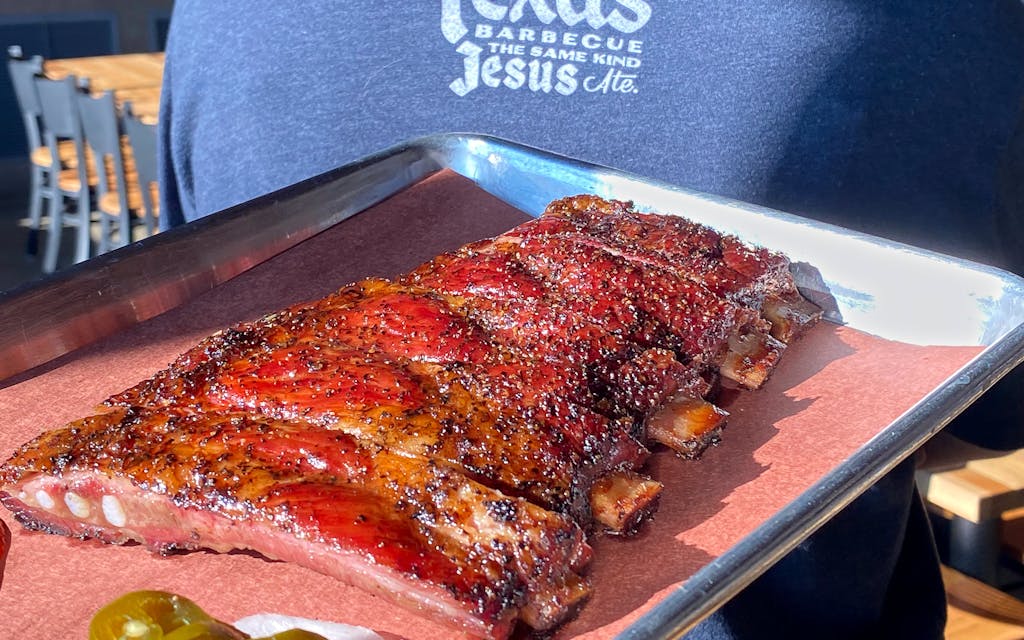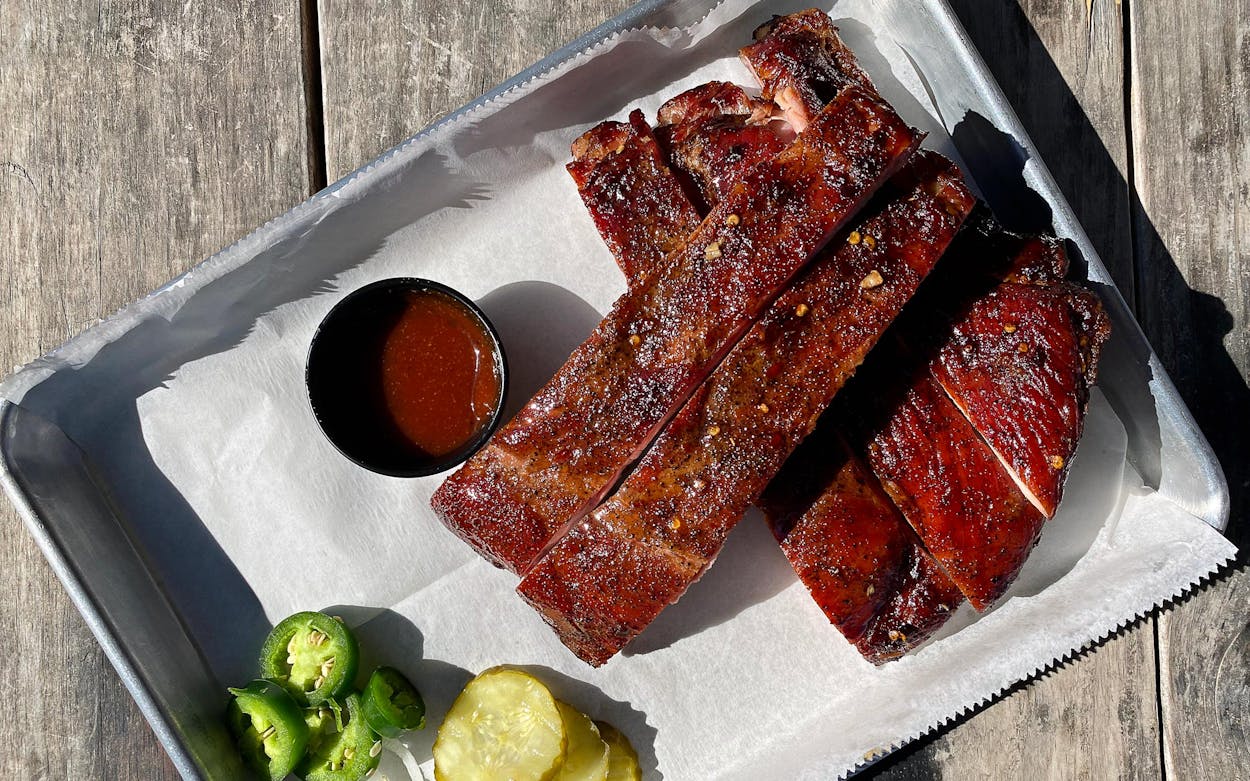Pitmaster Ren Garcia set a rib plate in the window of Micklethwait Craft Meats, in Austin. I had just eaten the smoked prime rib special, but the juices weeping from those behemoth spareribs were like a siren song. “How much for one rib?” I asked, without intending an I’m Gonna Git You Sucka joke. He handed me a small end rib right off the block, and I polished it off before I could walk to the trash can to deposit the bone. It wasn’t a sauced-up rib, which has become the norm in Texas. Micklethwait‘s rib tasted like salt, pepper, smoke, and—as is less common with today’s trendy sweet ribs—pork.
“There are a lot of lies in barbecue,” Tom Micklethwait told me before I got too far into salt-and-pepper worship. We sat down to talk about his savory ribs, and he set me straight on exactly what went on them. The thing is, there’s some sugar included. “It’s a flavor-balance issue,” he said. So the ribs aren’t totally savory, though a chocolate chip cookie is still sweet after a sprinkle of salt is added to enhance the other flavors. Micklethwait first uses a rub of salt, pepper, celery seed, coriander, and garlic, onion, and mustard powders. Then, when the ribs are nearly done, he squirts on a mix of primarily rice wine vinegar (it also has corn syrup, barbecue sauce, and yellow mustard) before wrapping the ribs in butcher paper. Not much of that thin glaze sticks to the ribs, and that’s the point. “Personally, I don’t like saucy ribs,” Micklethwait said. “I was looking for some shine and added moisture.” The finished product tasted like the simpler ribs of old-school Texas barbecue.
And I wanted more, so I consulted the latest Texas Monthly Top 50 barbecue list. Nearly every joint used the same process: season the ribs, smoke them, sauce them, then wrap them in foil to finish cooking. One photo after the next showed ribs glistening—and sometimes dripping—with sauce. I was reminded of a barbecue competition I judged some years back. After the judges laid out the six different ribs they would score, an older gentleman next to me surveyed the nearly identical specimens and said, “It looks like they all went to the same barbecue school.” It seems savory ribs are similarly endangered at newer barbecue joints, but I did find a few holdouts.


The spareribs at CorkScrew BBQ, in Spring, glisten like a candy apple, so I was sure they’d taste like one, but co-owner and pitmaster Will Buckman set me straight. CorkScrew’s ribs aren’t sweet, but Buckman spends too much on Compart Duroc pork ribs to not let them shine. “We didn’t want to cover [the pork flavor] up,” he said. “We wanted to accentuate it.” A half rack is a deal at just $16, and it is magnificent. The bits of red pepper tricked me into expecting some complex rub, but more than any of the ribs I tried for this article, these tasted like good pork.
“No sauce. No glaze. Nothing fancy,” Dustin Pustka wrote in a recent Facebook message about his pork ribs at Pustka Family Barbeque. I loved the food truck when it was parked in Hutto in 2018, and those peppery ribs haven’t changed a bit since Pustka found a new home on the southeast side of Temple in July. The truck is parked outside the building that will become the brick-and-mortar once the renovation is complete, but Pustka has no plans to move away from the savory flavors he started with. “I want to stick to the basics on the core menu, and let the meat speak for itself,” he said.
Damien Brockway of Austin’s Distant Relatives agrees. “It’s about the quality of the pork and the wood’s character,” he said of the important elements in his pork ribs. Any sweetness, he said, comes from the pecan smoke. Brockway does serve a tamarind molasses barbecue sauce on the side, but I thoroughly enjoyed the juicy, peppery spareribs on their own.
And if you think those saucy ribs are just the purview of new joints like Goldee’s Barbecue, in Fort Worth (whose sweet ribs, among other items, were good enough to garner it our top ranking for Texas barbecue joints), I witnessed a squirt bottle in action at the historic Louie Mueller Barbecue, in Taylor, on a recent visit. “We try to make everything as pretty as possible, and the one thing that really looks dull and drab if it’s not glistening is spareribs,” owner and pitmaster Wayne Mueller explained. He now sells three to four times as many racks as he did before he started adding the sweet sauce. And the glisten is hard to ignore. It makes a rib look more alluring in person and, maybe more importantly, in an Instagram photo.

“The trend moved, and we went against it,” Reid Guess told me as we shared a half rack of spareribs at his Guess Family Barbecue, in Waco. “Old school Texas barbecue, the same kind Jesus ate,” has been the joint’s motto since it opened in 2017. I asked him about that motto, now printed on staff T-shirts, and what it means to him today. “Salt and pepper, throw them on, then take them off. That’s it,” Guess said. There’s no sauce, no spritz, and the ribs aren’t wrapped. That means the edges get a little crisp, which is a variation in texture I value. The flavors of the fat, the pork, and the smoke come through best that way, which is easy to forget when you’ve been eating sweet ribs. Eating a Guess Family Barbecue rib feels nostalgic, which is odd at a place that’s been open for just five years. It’s a reminder of how good simplicity can taste.
Thankfully, the joy of a simply seasoned savory rib can also be found at legendary spots like Kreuz Market, in Lockhart; Southside Market in Elgin, Dozier’s, in Fulshear; and City Meat Market, in Giddings, among others. “The direction of the trend is away from traditional,” Micklethwait told me. I just hope the trend of sweet-glazed ribs that likely began as a way to stand out from those classically seasoned ribs can be reined in a bit now that it’s nearing ubiquity. Maybe an old-school savory-spareribs tour like the one I took is the antidote, lest commercial barbecue go the way of competition barbecue.








